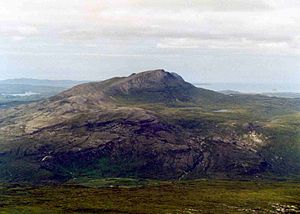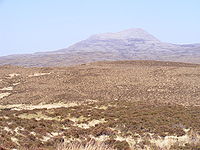Canisp: Difference between revisions
Created page with "{{Infobox hill |name=Canisp |county=Sutherland |range=Assynt |picture=Canisp_from_Conival.jpg |picture caption=Canisp seen from Conival |height=2,779 feet |os grid ref=NC20318..." |
No edit summary |
||
| Line 6: | Line 6: | ||
|picture caption=Canisp seen from Conival | |picture caption=Canisp seen from Conival | ||
|height=2,779 feet | |height=2,779 feet | ||
|latitude=58.120645 | |||
|longitude=-5.052629 | |||
|os grid ref=NC203187 | |os grid ref=NC203187 | ||
}} | }} | ||
| Line 15: | Line 17: | ||
Canisp is an isolated mountain that stands in the Glencanisp Forest, a large rock and water wilderness. It has a considerable topographic prominence of 2,280 feet making the mountain a very good viewpoint. Canisp has very little vegetation. Even on its lower slopes large areas of Gneiss (one of the oldest rocks in the world) are visible on the surface. | Canisp is an isolated mountain that stands in the Glencanisp Forest, a large rock and water wilderness. It has a considerable topographic prominence of 2,280 feet making the mountain a very good viewpoint. Canisp has very little vegetation. Even on its lower slopes large areas of Gneiss (one of the oldest rocks in the world) are visible on the surface. | ||
The mountain stands on the lands of the Glencanisp and Drumrunie Estates, a 44,000 acre tract of land which was bought in 2005 for £2,900,000 by the Assynt Foundation, a group of around 900 local residents, from the Vestey family. | The mountain stands on the lands of the Glencanisp and Drumrunie Estates, a 44,000-acre tract of land which was bought in 2005 for £2,900,000 by the Assynt Foundation, a group of around 900 local residents, from the Vestey family. | ||
Canisp is in the strange situation of being eclipsed by the nearby smaller mountain of [[Suilven]] which stands three miles to the west and is 381 feet lower in altitude. Suilven is a more popular mountain with its jagged summit ridge. | Canisp is in the strange situation of being eclipsed by the nearby smaller mountain of [[Suilven]] which stands three miles to the west and is 381 feet lower in altitude. Suilven is a more popular mountain with its jagged summit ridge. | ||
| Line 21: | Line 23: | ||
This is a geologically important area. It is part of the Moine Thrust Belt and is typical of many of the Assynt hills in that it rises from a base of Lewisian gneiss and is composed of Torridonian sandstone capped by Cambrian quartzite giving the hill a distinctive light grey crown. Its rocks show signs of major abrasions left by the scouring of the landscape by glaciation during the last Ice Age. | This is a geologically important area. It is part of the Moine Thrust Belt and is typical of many of the Assynt hills in that it rises from a base of Lewisian gneiss and is composed of Torridonian sandstone capped by Cambrian quartzite giving the hill a distinctive light grey crown. Its rocks show signs of major abrasions left by the scouring of the landscape by glaciation during the last Ice Age. | ||
Compared to the other Assynt hills, Canisp does not show any distinct topographic qualities. It is a fairly uncomplicated mountain with a symmetrical profile with two main ridges running | Compared to the other Assynt hills, Canisp does not show any distinct topographic qualities. It is a fairly uncomplicated mountain with a symmetrical profile with two main ridges running north-west and south-east. Its south-western flank has crags and scree which falls steeply into Glen Canisp, while its north-eastern slopes also fall precipitously to the lochan-studded moorland. | ||
==Ascents== | ==Ascents== | ||
[[File:Canisp from the east.jpg|left|thumb|200px|Canisp from the main starting point, to the east]] | [[File:Canisp from the east.jpg|left|thumb|200px|Canisp from the main starting point, to the east]] | ||
[[File:2011 Schotland Canisp 2-06-2011 16-55-08.png|right|thumb|200px|Canisp from Knockan Crag]] | [[File:2011 Schotland Canisp 2-06-2011 16-55-08.png|right|thumb|200px|Canisp from Knockan Crag]] | ||
The most popular ascent of Canisp starts at the north end of Loch Awe ({{map|NC249160}}) where there is car parking and a footbridge to cross the River Loanan as it leaves the loch. The route gains the summit by the south east ridge. This is the shortest and quickest route, but it is still | The most popular ascent of Canisp starts at the north end of Loch Awe ({{map|NC249160}}) where there is car parking and a footbridge to cross the River Loanan as it leaves the loch. The route gains the summit by the south-east ridge. This is the shortest and quickest route, but it is still four miles long, almost completely devoid of paths, and defended by stones, heather and bog. | ||
Another ascent from the east which also uses the | Another ascent from the east which also uses the south-east ridge starts at Stronchrubie where there is also a footbridge over the Loanan. Longer ascents are also possible from [[Lochinver]] and Ledmore Junction, both these routes utilise the path between the two places that traverses the length of Glen Canisp before leaving the glen to climb the mountain by either its north-west ridge (from Lochinver) or south-east ridge (from Ledmore). | ||
The route from Lochinver gains the | The route from Lochinver gains the north-west ridge by a path from Loch na Gainimh and is regarded by Hamish Brown as the most pleasing way up the mountain. | ||
The summit of Canisp is marked by a large stone built wind shelter. The view from the top of the mountain is regarded as one of the finest in Scotland giving all round views taking in the surrounding loch studded moorland, [[the Minch]] beyond Lochinver and most of the well known mountains of Assynt. | The summit of Canisp is marked by a large stone-built wind shelter. The view from the top of the mountain is regarded as one of the finest in Scotland giving all round views taking in the surrounding loch studded moorland, [[the Minch]] beyond Lochinver and most of the well known mountains of Assynt. | ||
==Outside links== | ==Outside links== | ||
Latest revision as of 17:23, 18 September 2018
| Canisp | |||
| Sutherland | |||
|---|---|---|---|
 Canisp seen from Conival | |||
| Range: | Assynt | ||
| Summit: | 2,779 feet NC203187 58°7’14"N, 5°3’9"W | ||
Canisp is a mountain in the parish of Assynt in Sutherland, 16 miles north of Ullapool. Canisp is listed as a 'Corbett' and a 'Marilyn' by virtue of its height; 2779 feet above sea level.
The mountain's name is from the Old Norse language and means 'White Mountain'.
Geography and Geology
Canisp is an isolated mountain that stands in the Glencanisp Forest, a large rock and water wilderness. It has a considerable topographic prominence of 2,280 feet making the mountain a very good viewpoint. Canisp has very little vegetation. Even on its lower slopes large areas of Gneiss (one of the oldest rocks in the world) are visible on the surface.
The mountain stands on the lands of the Glencanisp and Drumrunie Estates, a 44,000-acre tract of land which was bought in 2005 for £2,900,000 by the Assynt Foundation, a group of around 900 local residents, from the Vestey family.
Canisp is in the strange situation of being eclipsed by the nearby smaller mountain of Suilven which stands three miles to the west and is 381 feet lower in altitude. Suilven is a more popular mountain with its jagged summit ridge.
This is a geologically important area. It is part of the Moine Thrust Belt and is typical of many of the Assynt hills in that it rises from a base of Lewisian gneiss and is composed of Torridonian sandstone capped by Cambrian quartzite giving the hill a distinctive light grey crown. Its rocks show signs of major abrasions left by the scouring of the landscape by glaciation during the last Ice Age.
Compared to the other Assynt hills, Canisp does not show any distinct topographic qualities. It is a fairly uncomplicated mountain with a symmetrical profile with two main ridges running north-west and south-east. Its south-western flank has crags and scree which falls steeply into Glen Canisp, while its north-eastern slopes also fall precipitously to the lochan-studded moorland.
Ascents


The most popular ascent of Canisp starts at the north end of Loch Awe (NC249160) where there is car parking and a footbridge to cross the River Loanan as it leaves the loch. The route gains the summit by the south-east ridge. This is the shortest and quickest route, but it is still four miles long, almost completely devoid of paths, and defended by stones, heather and bog.
Another ascent from the east which also uses the south-east ridge starts at Stronchrubie where there is also a footbridge over the Loanan. Longer ascents are also possible from Lochinver and Ledmore Junction, both these routes utilise the path between the two places that traverses the length of Glen Canisp before leaving the glen to climb the mountain by either its north-west ridge (from Lochinver) or south-east ridge (from Ledmore).
The route from Lochinver gains the north-west ridge by a path from Loch na Gainimh and is regarded by Hamish Brown as the most pleasing way up the mountain.
The summit of Canisp is marked by a large stone-built wind shelter. The view from the top of the mountain is regarded as one of the finest in Scotland giving all round views taking in the surrounding loch studded moorland, the Minch beyond Lochinver and most of the well known mountains of Assynt.
Outside links
References
- The Corbetts and Other Scottish Hill, (SMC Guide) ISBN 0-907521-29-0
- Climbing the Corbetts, Hamish Brown, ISBN 1-898573-08-5